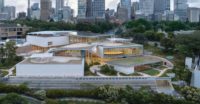Soon after the opening of the Oakland Museum of California fifty years ago, RECORD described the Dan Kiley gardens atop the Kevin Roche-designed building, as containing “rich ground covers, colorful flowering shrubs, and indigenous trees.” [RECORD, April 1970] Over the past half-century, however, the 26,400-square-foot terraced landscape—intended to function much like a public park—lost its vibrancy. The gardens, which encompassed koi ponds, sculpture courts, and shaded walkways, have devolved to what Oakland-based landscape architect Walter Hood characterizes as “static.” The now mostly-evergreen plantings display little seasonal variation and have become “duller and duller year after year,” he says. But this situation is about to change. The multidisciplinary museum, which focuses on art, history, and natural sciences, plans to break ground this fall on a roughly $20 million revitalization of its outdoor space designed by Hood.
The revamp comes almost a decade after completion of a comprehensive renovation by San Francisco architecture firm Mark Cavagnero Associates that touched almost every aspect of the Brutalist building except its gardens. The latest project, which includes Cavagnero as part of the design team, will create new outdoor gathering spaces and will devote areas of the stepped rooftops to the state’s various ecoregions. Hoods asks, “Since the museum is about California, why couldn’t the landscape be about California?”
Arguably, the most transformational aspect of the renovation could be the plan to partially demolish a perimeter wall at the campus’s northern corner. Hood uncovered an early scheme by Roche and Kiley showing trees defining this edge, and maintains that a more porous arrangement is true to their original intent. Removing the enclosure will improve access to the gardens and open them to the city and to views of adjacent Lake Merritt—the tidal lagoon at the edge of downtown. “From inside [the gardens] you will be connected to the world,” says Hood.
The refurbishment is slated to be complete by the fall of 2020.








Post a comment to this article
Report Abusive Comment